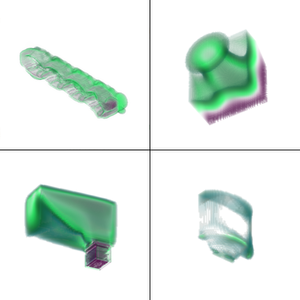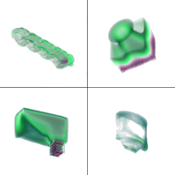Information
- Publication Type: Student Project
- Workgroup(s)/Project(s):
- Date: 2011
- Matrikelnummer: 625909
- First Supervisor: Erald Vucini
- Keywords: CUDA, GPU, Variational Reconstruction
Abstract
In this work we present a CUDA-based parallelized implementation of the reconstruction technique for 2D and 3D non-uniform point sets using a variational approach. Cubic B-splines are used as an approximation for the computationally expensive radial basis functions. As B-splines only have local support, a regularization term is added to handle larger gaps between sample points. The main reconstruction task is the solving of a large but sparse linear system. The system's size makes the use of iterative algorithms necessary. Different solvers are implemented in order to find the best-performing approach. GPU-based algorithms require a different kind of strategy than traditional implementations. The possible degree of parallelization becomes the defining factor for the efficient realization of algorithms. The use of B-splines also makes a multi-resolution approach possible. The system can be solved at a coarser representation and its solution acts as an initialization for the finer resolution. This further speeds up the reconstruction. A downside of using graphics cards for computation is the relative sparsity of available memory. Most GPUs are not capable of handling big datasets directly. Therefore, the non-uniform representation is split into a number of smaller blocks. Each block is then reconstructed separately and the intermediate results are joined together resulting in the final solution. The reconstruction results in terms of speed and quality are shown and are pitted against other CPU-based implementations. A CUDA based interactive ray-tracer is used to visualize the 3 dimensional datasets and test the visual quality of the reconstruction.Additional Files and Images
Weblinks
No further information available.BibTeX
@studentproject{Csuk_2011,
title = "CUDA-based Reconstruction and Visualization of Non-uniform
Point Sets",
author = "Maximilian Csuk",
year = "2011",
abstract = "In this work we present a CUDA-based parallelized
implementation of the reconstruction technique for 2D and 3D
non-uniform point sets using a variational approach. Cubic
B-splines are used as an approximation for the
computationally expensive radial basis functions. As
B-splines only have local support, a regularization term is
added to handle larger gaps between sample points. The main
reconstruction task is the solving of a large but sparse
linear system. The system's size makes the use of iterative
algorithms necessary. Different solvers are implemented in
order to find the best-performing approach. GPU-based
algorithms require a different kind of strategy than
traditional implementations. The possible degree of
parallelization becomes the defining factor for the
efficient realization of algorithms. The use of B-splines
also makes a multi-resolution approach possible. The system
can be solved at a coarser representation and its solution
acts as an initialization for the finer resolution. This
further speeds up the reconstruction. A downside of using
graphics cards for computation is the relative sparsity of
available memory. Most GPUs are not capable of handling big
datasets directly. Therefore, the non-uniform representation
is split into a number of smaller blocks. Each block is then
reconstructed separately and the intermediate results are
joined together resulting in the final solution. The
reconstruction results in terms of speed and quality are
shown and are pitted against other CPU-based
implementations. A CUDA based interactive ray-tracer is used
to visualize the 3 dimensional datasets and test the visual
quality of the reconstruction.",
keywords = "CUDA, GPU, Variational Reconstruction",
URL = "https://www.cg.tuwien.ac.at/research/publications/2011/Csuk_2011/",
}

 thesis
thesis
